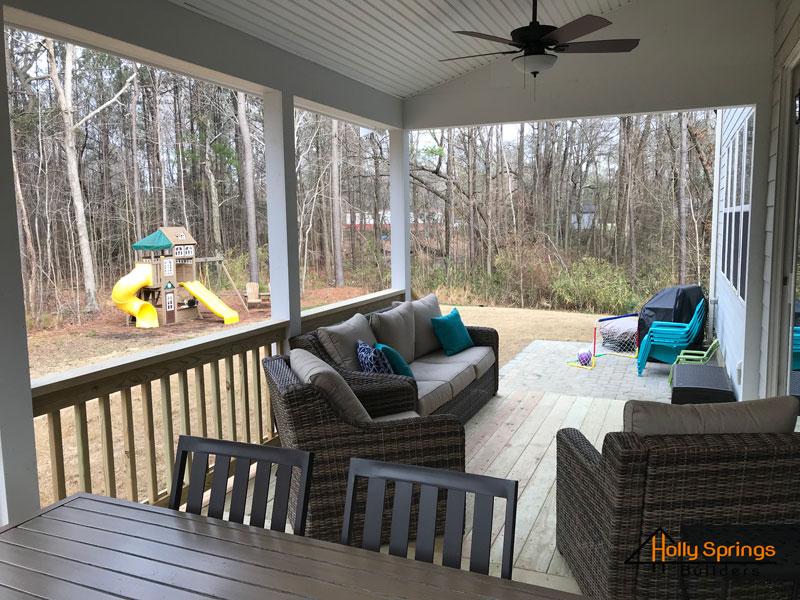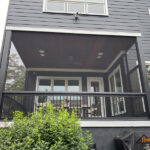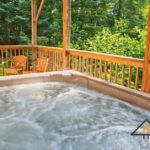North Carolina has four seasons — or so the Chamber of Commerce likes to say. In truth, our summers can be hot and humid, and winter may bring some bitter cold and the occasional snow or sleet.
That’s why choosing deck furniture requires a bit of consideration. The best furniture is going to hold up against the elements, plus its regular use. Here are some points as you shop for outdoor furniture.
1. Weather – As mentioned, we get the full variety here in  North Carolina allowing outdoor furniture to be exposed to various elements. Choose deck furniture out of materials that won’t warp or crack with the temperature changes. Wood may wear out, and lighter materials such as plastics are prone to blowing away during high winds. On the other hand, plastic is easier to clean following a flock of small birds or children. Of course, all that can be managed with storage and furniture covers. You can also treat wood with waterproofing if it’s not already painted or stained. Teak, cedar, aluminum, or all-weather wicker, are known for their durability and resistance to moisture, fading, and cracking.
North Carolina allowing outdoor furniture to be exposed to various elements. Choose deck furniture out of materials that won’t warp or crack with the temperature changes. Wood may wear out, and lighter materials such as plastics are prone to blowing away during high winds. On the other hand, plastic is easier to clean following a flock of small birds or children. Of course, all that can be managed with storage and furniture covers. You can also treat wood with waterproofing if it’s not already painted or stained. Teak, cedar, aluminum, or all-weather wicker, are known for their durability and resistance to moisture, fading, and cracking.
2. Function – Comfort is key when it comes to outdoor furniture. Are you sitting down to a family meal, hosting guests for a bonfire, or putting your feet up with a good book? You might be doing all three, but it’s best to start with your main and most frequent use. Also, you might think you want a dining table, but if you’re mostly hosting friends for after-work drinks, it may get in the way. Wicker couches and chairs are becoming more popular because you can put together a living room set up outside.
 3. Practicality – Do you want removable cushions so you can store them when not in use or covers to protect all of them? Do you need fold-up furniture so you can store it more easily? Consider whether you going to need to store the furniture and/or cushions in the harsher weather.
3. Practicality – Do you want removable cushions so you can store them when not in use or covers to protect all of them? Do you need fold-up furniture so you can store it more easily? Consider whether you going to need to store the furniture and/or cushions in the harsher weather.
4. Comfort – A lot of deck furniture looks good and holds up well, but no one sits on it. Why? It’s not comfortable. Look for pieces with well-padded cushions, ergonomic designs, and appropriate support. Try out the furniture before you buy and think about whether you’d sit in that chair for an hour or more at a time.
5. Aesthetics – Designers will encourage you to match the look of your home’s exterior, but we’ve also seen people go the other way and create a nice outdoor space. Wooden furniture is often popular for matching because you can change up the look by adding pillows. Deck furniture should complement the overall style and decor of your outdoor space. Always consider the color scheme and patterns.
6. Extras – The little extras are what really pull your outdoor space together.
- Place an outdoor rug under your conversational grouping of furniture.
- Add pillows and a throw or two for cooler nights.
- Post potted plants around the edges.
- Add lighting and ambiance.
- Don’t forget to decorate. You can hang art on your exterior walls or on a lattice.
- Canvas or sail shades overhead can create a sense of space.
Bonus tip: Measure and map! More than once we’ve seen a homeowner with too much furniture for the space, making it look cluttered — or forcing them to return some things. Try drawing out your deck or patio dimensions on paper creating your space. Draw in where a table, chair, or couch might go and get the measurements online for those pieces. And make sure there is enough space to comfortably walk around the furniture.
And remember, if you want to make that deck a bit bigger or screened, just give me a call or shoot me a text 919-346-0678!







